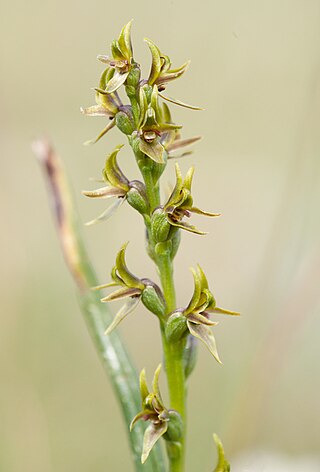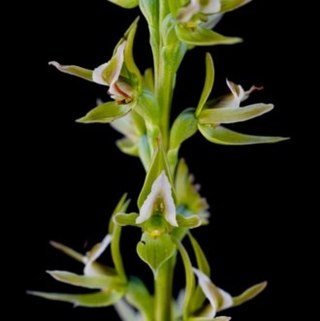
Prasophyllum tadgellianum, commonly known as the alpine leek orchid, is a species of orchid native to the Snowy Mountains and Tasmania. It has a single stiff, erect leaf and up to twenty scented, greenish-brown or reddish-brown flowers crowded on a stout spike.
Prasophyllum pyriforme, commonly known as the graceful leek orchid is a species of orchid species endemic to eastern Australia. It has a single tubular leaf and up to fifty greenish flowers with a pink or white labellum. As with others in the genus, the labellum is above the column rather than below it.
Prasophyllum australe, commonly known as the southern leek orchid or austral leek orchid, is a species of orchid and is endemic to south-eastern Australia. It has a single tubular, green leaf and up to fifty scented, greenish-brown flowers with red stripes.
Prasophyllum anticum, commonly known as the Pretty Hill leek orchid, is a species of orchid endemic to Victoria. It has a single tubular, dark green leaf and between ten and twenty five scented, greenish-brown flowers and is only known from a small area in the south-west of the state.

Prasophyllum petilum, commonly known as the Tarengo leek orchid, is a species of orchid endemic to eastern Australia. It has a single tubular, green leaf and up to eighteen pinkish mauve to greenish flowers, well-spaced along a slender flowering stem. It is a small orchid, difficult to locate, generally growing in taller grasses.

Prasophyllum montanum, commonly known as the mountain leek orchid, is a species of orchid endemic to eastern Australia. It has a single tubular, green leaf and up to fifty scented, greenish to pinkish flowers. It grows in montane ecosystems at altitudes above 1,500 m (5,000 ft).
Prasophyllum campestre, commonly known as the sandplain leek orchid, or inland leek orchid, is a species of orchid endemic to eastern Australia. It has a single tubular, yellowish-green leaf and up to twenty greenish, strongly scented flowers with red, purplish, brown or white marks. It grows in the drier parts of Queensland, New South Wales and Victoria.

Prasophyllum odoratum, commonly known as the fragrant leek orchid, Rogers scented leek orchid or sweet leek orchid is a species of orchid endemic to south-eastern Australia. It has a single tubular leaf and up to fifty fragrant green and white flowers with reddish marks.

Prasophyllum caudiculum, commonly known as the Guyra leek orchid, is a species of orchid endemic to a small area of northern New South Wales. It has a single tubular, bright green leaf and up to thirty five greenish to reddish-brown flowers crowded along an erect flowering stem. It grows in grassy places near Guyra.
Prasophyllum brevilabre, commonly known as the Gorae leek orchid, is a species of orchid endemic to south-western Victoria. It has a single tubular, green leaf and up to forty greenish-brown flowers with reddish markings. It is a very rare orchid, now only known from two small, scattered populations. It was first recorded from Gorae West near Portland but is no longer found there.
Prasophyllum gilgai, commonly known as the gilgai leek orchid, is a species of orchid endemic to Victoria. It has a single tubular green leaf and up to twenty greenish brown, light brown, pink or white flowers. It is a very rare orchid with a population of fewer than fifty plants in a small area in the north of the state.
Prasophyllum hygrophilum, commonly known as the swamp leek orchid, is a species of orchid endemic to Victoria. It has a single tubular green leaf and up to thirty greenish brown, pink or mauve flowers. It is a rare orchid only known from two populations and is classified as "endangered" in Victoria.

Prasophyllum maccannii, commonly known as the inland leek orchid, is a species of orchid endemic to Victoria. It has a single tubular green leaf and up to forty green, greenish-pink or brownish flowers. It is found in the central-west of the state, growing in open forest.
Prasophyllum occultans, commonly known as the hidden leek orchid, is a species of orchid endemic to southern Australia. It has a single, smooth, tube-shaped leaf with a reddish-purple base and up to ten greenish flowers. It is a rare species found only in a few locations in South Australia and in far western Victoria.
Prasophyllum parviflorum, commonly known as the slender leek orchid, is a species of orchid endemic to eastern Victoria. It has a single tubular leaf and up to thirty greenish-brown to purplish flowers. Further studies of the species may indicate that some collections currently included may be of a different species.

Prasophyllum patens, commonly known as the broad-lipped leek orchid or sandstone leek orchid, is a species of orchid endemic to the Sydney region of New South Wales. It has a single tubular green leaf and up to thirty green to greenish-brown, lemon-scented flowers with a white labellum.

Prasophyllum viretrum is a species of orchid endemic to Victoria. It has a single tubular, dark green leaf and up to thirty five scented, greenish-brown to brownish flowers and is only known from a few small populations in south-western Victoria.
Prasophyllum roseum, commonly known as the pink lip leek orchid, is a species of orchid endemic to southern continental Australia. It has a single tube-shaped leaf and up to thirty greenish flowers with a pink labellum. It is a recently described plant, previously included with P. fitzgeraldii, but distinguished from that species by its smaller, less crowded flowers, with more spreading lateral sepals and different labellum callus. It grows in the south-east of South Australia and in western Victoria.
Prasophyllum spadiceum, commonly known as the brown lip leek orchid, is a species of orchid endemic to southern continental Australia. It has a single tube-shaped leaf and up to thirty pale green, brown and white flowers with a whitish labellum. It is a recently described plant, previously included with P. fitzgeraldii, but distinguished from that species by its smaller, paler flowers, whitish labellum and brown callus. It grows in the south-east of South Australia and in a single location in western Victoria.
Prasophyllum stygium, commonly known as the elfin leek orchid, is a species of orchid endemic to Victoria. It has a single tube-shaped leaf and up to twenty greenish-brown flowers with a white labellum. It is a recently described plant, previously included with P. fitzgeraldii, but distinguished from that species by its greenish-brown flowers with their white labellum and narrower brown callus. It is only known from a single population of about thirty plants.









